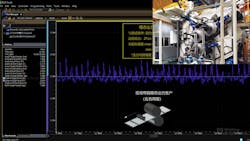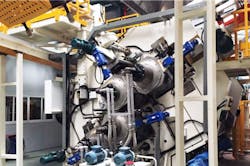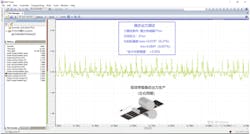Advanced Hydraulics and Controls Make Calendering More Precise and Efficient
The calendering industry, like most others, is competitive, and calendering companies strive to keep up with, if not go beyond, the conventional technologies used in it to gain an edge. At JiangYin QinLi Rubber Machinery Co. Ltd. in China, management and engineers decided to upgrade their hydraulic actuators and controls to boost productivity and efficiency.
Calendering is the process by which textiles, plastics, metals and rubber are sent between a pair of hard rollers to smooth or finish them. The process was invented by Charles Goodyear, who used it on rubber in the 1800s. The Goodyear Tire & Rubber Co. remains a dominant player in the field of calendering to this day.
Across its rubber, plastic, metal and fiber film operations, JiangYin QinLi needs to deliver consistent quality while being the most economical supplier on the market. In calendering, quality generally stems from maintaining minimal thicknesses while preserving material tolerances. Doing so, however, makes mechanical calendering machines cumbersome. And machines that rely on electric motors to move rollers require manually adjusting the gap between rollers, as different materials require different roller spacing.
It is difficult to calibrate this gap on mechanical equipment, and making adjustments can take considerable time. Even under the best conditions, it is difficult to maintain a precise gap due to changing environmental conditions and constant wear on parts experience wear.
The arrival of hydraulic calendering over the last several years has opened the door to new ways to improve on mechanical calendering. With hydraulic calendering, rollers are moved by hydraulic cylinders, giving the cylinders a virtually infinite range of positionings to meet more demanding production needs.
For example, customers for calendered rubber sheets now expect available thicknesses to include those from 0.05 to 0.1 mm with tolerances of ±0.01 to 0.005 mm. In some extreme cases, they need tolerances of ±0.0025. These tolerances are difficult to execute, but holding such tight tolerances saves on raw materials and reduces manufacturing costs while improving sales due to higher-quality product—at least for the few manufacturers able to manage it.
JiangYin QinLi took its technical specifications and reached out to Wuxi Forever in search of an end-to-end, best-in-class calendering solution. The integrator assisted in everything from schematic design to post-deployment support and supplied everything from transducers and motion controllers to cylinders and hydraulic power units. Wuxi Forever even crafted an HMI terminal in which velocity, cylinder distance and required margin are all controlled by technician using a touchscreen.
JiangYin QinLi makes machines with two-, three-, or four-roller calendering. Two-roller machines are often tasked with processing raw material while three- and four-roller versions process final products.
With Wuxi Forever’s guidance, the company installed synchronous serial interface (SSI) position transducers (MDTs) from MTS and Wuxi Forever, and pressure sensors from Gefran. On a new two-roller extrusion machine, it added an RMC75E electrohydraulic motion controller with two-axis MA2 and AP2 expansion modules from Delta Computer Systems. Their new four-roller machine uses a eight-axis Delta RMC151E with S2, H1 and U I/O modules to press either rubber or fiber films.
The Design team chose Delta controllers based on their experience with ones that sequenced more smoothly between pressure and position control than other controllers. Many motion controllers suffer a position jump when transitioning between control modes (force versus position), and this deforms the calendered product. Delta controllers showed no such bounce. Additionally, Delta provided advanced control algorithms, including those using high-order gains to control the cylinder acceleration, as well as cylinder position and velocity. JiangYin QinLi engineers found it straightforward to use the RMCTools that came with the controller to create new algorithms.
The controller’s built-in programming commands let the devices easily handle dual-loop control in which pressure is monitored while position is being controlled. The dual-loop control also makes smooth transitions between position/velocity and pressure/force modes. The Delta’s integrated protocols facilitate seamless communication between the RMC and connected transducers, PC/PLCs and valves.
“These RMC advantages are critical for solving ever-present calendering issues such as cylinder synchronization and reducing oscillations when pressing layers thinner than 50 to 70 µm,” notes JiangYin QinLi’s chief engineer YeGang Zhou. “The Delta controllers maintain synchronization to within a margin of ±0.003 mm for cylinders without loads. They also provide the responsiveness needed for quick, critical adjustments to load changes.”
Hydraulic-controlled calenders are a clear trend in cutting-edge manufacturing. With modern motion control systems, they can deliver a wide array of benefits, says JiangyYn QinLi’s chief engineer YeGang Zhou. “Beyond rubber, our new calendering machines can also be used in semi-steel liner production which can have margins as small as 0.001 mm for position control of rollers moving 7 mm per second.
“With a response time of only milliseconds, the new equipment reduces material loss when changing specifications,” Zhou adds. “This saves money compared with traditional mechanical calenders and improves production efficiency, product quality and consistency.”
About the Author
Stephen Mraz
Steve serves as Senior Editor of Machine Design. He has 23 years of service and has a B.S. Biomedical Engineering from Steve was a Flight officer in the U.S. Navy. He is currently responsible for areas such as aerospace and medical.



